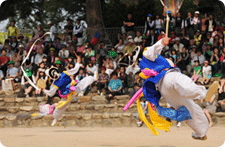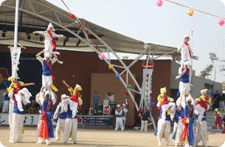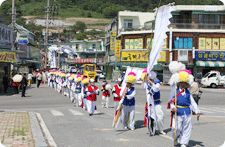Nongak originated from communal rites and rustic entertainments that promoted harmony as people gathered to pray for peace and prosperity. It has evolved into a representative performing art genre of Korea, widely performed and enjoyed by all Koreans.
Nongak has been practiced for various purposed, such as appeasing gods, chasing evil spirits and seeking blessings, praying for a rich harvest in spring, celebrating the harvest in autumn festivals, and professional entertainment.
|  |
Any joyful community event was never complete without music and dance performed by the local band clad in colourful costumes. The music frequently uses uneven beasts of complex structures like simple three-time, compound time, and simple time and compound time. Small hand-held gongs and hourglass drums play the main beats, while large gongs and barrel drums create simple rhythmic accents.
|  |
Nongak has distinctive regional styles, generally divided among five cultural centers: Gyeonggi/Chungcheong provinces, Gangwon Province, North/South Gyeongsang provinces, and North/South Jeolla provinces subdivided into East/West Honam regions. Within each area, differences exist from one village to another in band composition, performing style, rhythm, and costumes. The central government designated six elements of Nongak as the important intangible cultural heritage: Jinju/Samcheonpo Nongak, Pyeongtaek Nongak, Iri Nongak, Gangneung Nongak, Imsil Pilbong Nongak, Gurye Jansu Nongak.
|  |






 >
>